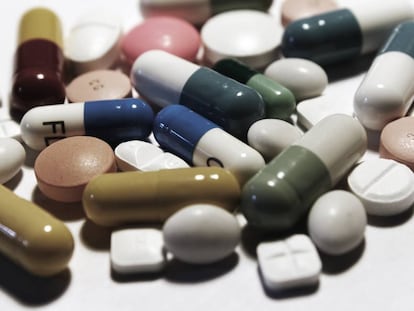Why are new drugs so expensive?
US legislation, profit motives, medical advances and patents are some of the reasons why new treatments are becoming more and more costly

Breaking the record for the world’s most expensive drug is often a short-lived distinction. Zolgensma, a single-dose treatment for spinal muscular atrophy made by Novartis, won that title in May 2020 when it was first marketed in Europe with a price tag of nearly €2 million ($2.17 million). Seven months later, the European Commission approved Libmeldy from Orchard Therapeutics, a therapy for a fatal genetic disease called metachromatic leukodystrophy, which cost €2.47 million ($2.68 million) per vial. Next it was bluebird bio’s turn. In August 2021, the US company announced that Zynteglo, newly approved in the United States to treat a hereditary blood disorder, would cost $2.83 million (€2.6 million). A month later, the same company put a $3.04 million (€2.8 million) price tag on Skysona, a treatment for a neurological disorder called adrenoleukodystrophy. That record lasted less than three months. In December 2022, CSL Behring announced that its Hemgenix gene therapy for hemophilia type B would cost €3.3 million ($3.59 million) per treatment.
This new wave of innovative therapies has rekindled hope in patients facing short or restrictive lives due to diseases for which there are no effective treatments. But the skyrocketing prices of these drugs are straining the sustainability of healthcare systems. Spending on prescription drugs has tripled in the United States since 2000, and Spanish public hospitals now spend twice as much on oncology therapies than they did five years ago.
Experts think this trend will continue in the coming years. There are hundreds of drugs in various stages of development aimed at unmet therapeutic needs, and every new treatment that obtains regulatory approval tends to cost more than existing drugs. The drivers for this trend include legal, economic and scientific factors.
The US market
The United States is the center of gravity for the global pharmaceutical market. With only 4.2% of the world’s population, the industry’s annual sales in the US amount to $556 billion (€512 billion), almost half of the global total, according to 2021 data compiled by Statista. Europe’s population is much larger than the US population (447 million versus 332 million), but spends less than half as much on pharmaceuticals – €222 billion ($241.3 billion).
One reason for the difference are American laws that favor Big Pharma. There is little price regulation in the US, so companies are free to charge whatever the market will bear and raise prices at will. A law enacted in 2003 even prohibits Medicare, the public health insurance program for people over 65, from using its enormous purchasing power to negotiate lower prices.
In European countries, public health insurance programs do have the ability to negotiate prices and subject drugs to rigorous cost-benefit evaluations before buying. But pharmaceutical companies set prices with the global market in mind, so even if buyers win some discounts, prices in Europe are also high due to the influence of less regulated markets.
The law that changed everything
Marcia Angell, a former editor-in-chief of one of the world’s most prestigious medical journals, The New England Journal of Medicine, wrote about how a single law changed the industry in The Truth About the Drug Companies (2004). Before 1980, pharma industry dynamics were predictable and dull – companies did research, brought drugs to market, and set prices that didn’t shock payers. Scientific breakthroughs made with federal funding were automatically in the public domain, which helped control prices.
The Bayh-Dole Act, which was designed to accelerate development of new treatments, changed the business model by allowing the privatization of knowledge developed with federal funding. Scientists, universities, research centers and small companies were able to patent their inventions and then sell them to pharmaceutical companies under “exclusive licenses.” That’s when a slew of small start-ups emerged. Their model was to identify the most promising molecules or processes, attract investment and begin the lengthy drug development effort. At some point along the way, these start-ups sold out to an industry giant for millions of dollars. All this requires huge financial investments that demand high returns, which is why new therapies cost more when they eventually hit the market.
Enrique Castellón is a former top official in Spain’s Ministry of Public Health who now is an advisor to Cross Road Biotech, a private venture capital management firm. He says the Bayh-Dole Act marked a turning point for the industry. “It had an enormous impact, the consequences of which are still being discussed. Advocates say it led to a massive influx of private capital that spurred innovation and the development of revolutionary treatments. But critics argue that it led to price inflation in health care.”
A very profitable industry
The pharmaceutical industry is profitable. A study published in the March 2020 issue of JAMA found that the 35 largest public pharmaceutical companies in the US earned revenues almost double that of 357 companies in other sectors (13.8% compared to 7.7%). A 2015 report by consulting firm McKinsey & Company reached the same conclusion.
Big profits start with higher prices. Experts say this is the cost of admission to the new game established by the Bayh-Dole Act. “Companies in this sector need a lot of capital to fund their research. They compete to attract investors, and the way to succeed is to offer high returns,” said Enrique Castellón.
The Bayh-Dole Act’s impact spread around the world as other countries began to adopt similar models. Many European pharmaceutical companies opened development centers in the United States to be closer to new business opportunities. Large companies stopped relying solely on their own research and began competing to acquire the most promising start-ups at ever higher prices, which in turn inflated drug prices.
Innovation risk
The pharma industry argues that high levels of profitability are needed to continue funding innovation in a very risky field. Development costs are rising and many drugs never make it to market. According to the European Federation of Pharmaceutical Industries and Associations (EFPIA), only one in 10,000 molecules studied will eventually become a drug; only one in 167 drugs in development will reach the market; and only one in five drugs sold will generate enough revenue to cover the investment.
The drug development process is expensive and lengthy – as long as 10 years. According to a benchmark study published in 2016 by Joseph DiMasi (Tufts University, USA), the average investment in research and development in 2014 amounted to nearly $2.6 billion (€2.4 billion), more than double the tally a decade earlier.
However, industry sources provided the data used in DiMasi’s study, which led others to question its conclusions. Neboa Zozaya, director of health economics at the Weber Foundation, claims that very little is really known about the real cost of pharmaceuticals. “There is a lot of opacity in the cost structures of these companies, and you have to consider that much basic research is publicly funded. There is also a major debate about how to account for the costs of drug development projects that are ultimately cancelled.”
Critics say the underlying problem is that companies and investors insist on including the costs of all their failures in the prices of new drugs. If they factor in the healthy profits from successful drugs, their risk isn’t as high because costs are always passed on to patients and healthcare systems.
Precision medicine
Juan Oliva, a professor of health economics at the University of Castilla-La Mancha (Spain), highlights another factor contributing to rising prices. “Many new therapies are aimed at a very small number of patients. This is especially true for rare diseases, but also for more common diseases such as cancer when a drug is only indicated for a very specific process or a very specific point in the progression of the disease. A drug that can only be used by a small number of people is logically going to be more expensive.”
This type of precision medicine is like a dog chasing its own tail. The high price of new drugs means that payers – whether public or private insurers – will only reimburse their cost in cases where there is strong evidence of their effectiveness and when there are no cheaper alternatives. This further reduces the number of potential patients, again driving up prices.
Pricing policies
Pharmaceutical companies don’t set prices by first calculating costs and then adding on a profit margin. They use a method called “value-based pricing.” Pfizer CEO Albert Boula’s book about the company’s Covid-19 vaccine development effort, Moonshot: Inside Pfizer’s Nine-Month Race to Make the Impossible Possible, says that Pfizer prices its medicines by calculating the value they bring to patients, the healthcare system and society as a whole. Using this method, to calculate the price of a heart therapy that prevents five heart attacks in 100 people, Pfizer estimates the entire cost of treating the five patients – health care, hospitalization, sick leave, etc. – and divides the total by the 100 people treated.
Neboa Zozaya says this is why CSL Behring’s Hemgenix drug costs so much. “Hemophilia patients already receive very expensive treatments. In these cases, the prices tend to be higher because they include the potential overall savings to the health care system that companies think they are providing,” she said. This begs the question of whether these system-wide savings will ever materialize. There is often much uncertainty about the true long-term efficacy of some treatments, and many question whether it is reasonable for pharmaceutical companies to charge for them up front.
In Europe, it is not uncommon for public health systems to reject paying for treatments that they believe provide little health value for the money. Negotiations to introduce new therapies can sometimes drag on for months or even years. Most of the time, the two parties reach an agreement, but the outcomes can be dramatic. Bluebird bio obtained regulatory approval for Zynteglo from the European Medicines Agency (EMA) before the US Food and Drug Administration (FDA) signed off. The company began selling the drug in Germany in January 2020 for €1.6 million ($1.74 million) per treatment, which later rose to €2.6 million ($2.83 million). A year later, German public health officials wanted the company to drop the price to €600,000 ($652,000) based on the observed health benefit. The company angrily responded by pulling its products from European markets. “Governments have not yet adequately recognized the innovative value of our therapies,” said bluebird bio CEO Andrew Obenshain.
Patents
Patents offer companies temporary monopolies during which no one else is allowed to market the same drug. Patent protection typically lasts 20 years, but 10 of those years elapse during the development process. Companies charge high prices so they can recover investments and reward shareholders as quickly as possible before other treatments in development are launched and begin eating into market shares.
“The most important reason for the high cost of prescription drugs is the existence of monopoly,” writes S. Vincent Rajkumar in an article published in the June 2020 issue of Blood Cancer Journal. Many experts and organizations agree, and fault patents for slowing down innovation. They claim that patent holders tend to wait for protection to expire on one drug before starting development of another, more effective treatment.
Jaime Manzano, a researcher with Spain’s Right to Health Foundation, believes that the lack of cost transparency, the use of value-based pricing methods and patents all “foster a spiral of overpricing. Because of their monopoly power, prices are ultimately determined by the leverage pharmaceutical companies have over the public health systems.” Given the urgency of providing treatment to often desperate patients, this “leads to ever higher prices.”
But many of the experts we interviewed noted another facet of patenting. “Without them, prices would certainly be lower. But there would also be less innovation because there would be less investment. That translates to fewer drugs in development because of less available funding. When we seek investors, one of the first questions they ask is about patent protection,” said Castellón.
Beatriz González López-Valcárcel, a professor of economics at the University of Las Palmas de Gran Canaria (Spain), believes that the patent system is necessary for the time being even though it’s “imperfect and in need of some patching… Mankind has not come up with a better way of fostering innovation and R&D investment to produce goods for the world, which is what happens when patents expire and allow anyone to produce and sell drugs for very low prices.”
Sign up for our weekly newsletter to get more English-language news coverage from EL PAÍS USA Edition
Tu suscripción se está usando en otro dispositivo
¿Quieres añadir otro usuario a tu suscripción?
Si continúas leyendo en este dispositivo, no se podrá leer en el otro.
FlechaTu suscripción se está usando en otro dispositivo y solo puedes acceder a EL PAÍS desde un dispositivo a la vez.
Si quieres compartir tu cuenta, cambia tu suscripción a la modalidad Premium, así podrás añadir otro usuario. Cada uno accederá con su propia cuenta de email, lo que os permitirá personalizar vuestra experiencia en EL PAÍS.
¿Tienes una suscripción de empresa? Accede aquí para contratar más cuentas.
En el caso de no saber quién está usando tu cuenta, te recomendamos cambiar tu contraseña aquí.
Si decides continuar compartiendo tu cuenta, este mensaje se mostrará en tu dispositivo y en el de la otra persona que está usando tu cuenta de forma indefinida, afectando a tu experiencia de lectura. Puedes consultar aquí los términos y condiciones de la suscripción digital.











































